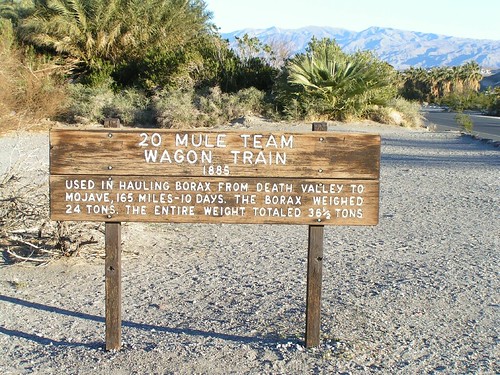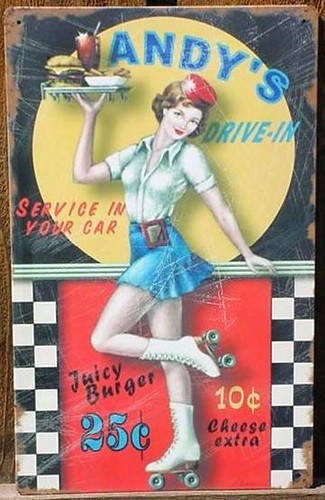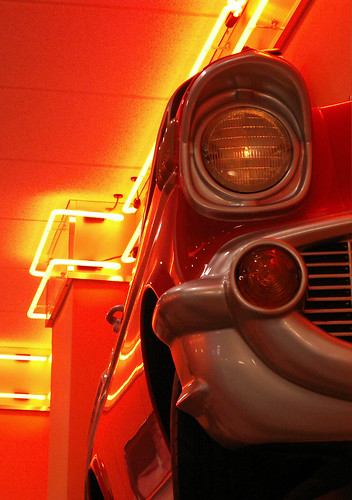DEATH VALLEY DAZED
By: Mike Marino

California is a smorgasbord of yin's and yang's.

Southern California, is the Pacific coast playground of the rebel without a cause hot rod car culture and Surf City, where, the Beach Boys promise, there are two girls for every boy. Northern California however, is the John Muir high country of the Sierra Nevada Mountains and the majesty of Yosemite. Coastal redwoods and mountain sequoias, woodland giants in a rich Lord of the Rings environment that encourages contemplation and meditation. The City of Lost Angels, home to lights, cameras, action! Hollywood! San Francisco to the north, is where the North Beach beat goes on much as it did in the Kerouac era of cheap port and poetry, and Haight Ashbury in the Sixties was the gravitational center of a new spiritual and political universe spinning out of control in a psychedelic orbit. California Dreamin' was becoming an eight mile high rolling paper reality with it's non-stop influx of youthful immigrants from the middle west middle class seeking an upbeat Upton Utopia that turned out to be as disorienting as an opium dream at best.
I had been living in the Haight since early 1966 and by the time of the Summer of Love Normandy Invasion of 1967, the streets had lost their luster, and were now a charlatans cacophony of spare changers, speed freaks, heroin dealers and predators. Hip was dead and buried, and I packed it up for the insane sanity of North Beach. My girlfriend at the time, Myrika, was a German artist and musician who had come to the states for a short visit and decided to stay. She sketched and painted while I spent hours writing in my journal, as our North Beach days were spent in exploration of the artistic and literary abstract, along with some of the best Italian sausage and vino in town. One night while walking along strip club infested area of Columbus Avenue near our apartment , she asked about the American deserts. Germany, famous for forests, lakes and rivers it seems, did not have a desertstrasse to save it's life and wanted to experience the expanse and tranquility only it can offer. Infinity itself, defined in terms of endless horizons and a vast ocean of sand, plants and animals. She wanted to sketch "stories" as she called them of the desert diversity and illusions it can create. She also just wanted to hear, experience and tape record the howl of the romantic Cary Grant leading man of the desert, the coyote.

it didn't take much to persuade John and his girlfriend, Olivia, good friends of mine and kindred spirits in Berkeley, to gas up the aging, coughing VW Microbus he owned to take to the road and head to Death Valley near the Panamint Mountains in southern California. Both were aspiring filmmakers so this was a f-stop opportunity to photograph and film a day in the life of the desert, except that day would turn into two weeks of more than just Ansel Adams antics. The peace symbol festooned magic microbus picked us at our apartment and was already fully loaded with Nikons, black & white film, two movie cameras, 16 mm film, cooking equipment, sleeping bags, food, wine, books, tripods, two kites, lanterns, built in camp cook stove, and a load of wood for fires John always kept handy for the many trips we would make down the coast to Big Sur to camp on the beach. The bus had been named Big Sur in the beaches honor one night around a big blur of a drunken campfire on the big beach at Big Sur. We did Big Sur it once again that night as it would have been blasphemy not to and headed out the next morning after a magnificent sunrise for the land of borax, mule teams of twenty and a saltwater lake called Bad Water. On the road again, cutting over to San Luis Obisbo, then Bakersfield and then into the valley of death rode the microbus four.
Death Valley National Monument, as it was first designated in 1933, was elevated to "park" status in 1994. Tourism was off and running from the starting line in the 1920's as Henry Ford's assembly lines went on blue collar factory overdrive to mass produce automobiles at a pace and price within reach of the motor mad masses. The supposed curative powers of Death Valleys natural springs attracted tourists during the flapper era of the Roaring Twenties like buzzards feasting on roadkill. Roosevelt, Franklin, not Eleanor, had the WPA programs include the blazing of trails through the Panamint Range of the desert area and campgrounds were set up to accommodate the new trade of auto-tourism.
We arrived in Death Valley near the end of the day so decided to park it and camp it. In those days you could pretty well just pull off the side of the road and set up your rustic version of Xanadu and rule the realm, and we made it to Bad Water which is about the limbo pole low as you can go in the continental United States at a basement foundation depth of 282 feet below sea level. We unloaded the sleeping bags, cook gear and food, along with one of the kites, three bottles of wine and flannel shirts for later in the evening. Limited campfires were permitted in those days, and a pit dug in the sand sufficed as fire pit. John, in his Muir-like wisdom had brought an ample supply of firewood along for numerous small fires as opposed to one that would reach the sky and herald the opening ceremony of a Burning Man gathering of the tribes. We got the camp stove fired up, black beans and rice ready to be transformed into the eighth wonder of the gastronomical world and as the sun began to set we started the small fire, broke out a guitar and my harmonica as Myrika sketched madly away in her book, Olivia unloading her camera for some color shots of the sunset, John strumming away on the Gibson to his own tune, and me playing along on harmonica, as best I could, to a desert blues tune.
Sunsets have a mystical sense all their own, but a desert sunset framed by the changing hues of the Panamint mountains is a Billie Holiday command performance at Kennedy Center. The Bad Water low point's highpoint is Telescope Peak, which is worn by the mountain range with all the flair of a ruby tiara adorning the head of a goddess. The peak changes hues in perfect harmony with the setting sun playing on it's rock solid surface, transforming it into a granite lava lamp 11,000 feet tall. At least that was the impression, and yes, it could have been brought on by the wine, or something. We talked and at times, not talked for timeless hours witnessing the sky darken itself into coal black, revealing the stars turned on as stage lights on opening night, filling the galactic auditorium with a band of diffused light that crossed the sky. The Milky Way was now Broadway and we had balcony seats for the big show. We heard the first note of the coyote chorus around 11pm and Myrika dashed for her tape recorder, which was one of those old, solid as a '57 Buick reel-to-reel portable jobs with pro model microphone, and watched her as she hoped for the best in capturing the call of the wild. The rest of the evening was spent emptying the cheap bottles of wine, watching the dying embers of the fire and basking in the glow of the camp lantern hung on the open side door of Big Sur. Not enough room to sleep all inside so we took turns each night. John and Liv one night, Myrika and me the next, and so on, so on, so on. Sleeping on the desert floor with it's surrounding silence, organic surface and night scents was more intoxicating than the wine. Yes, life is a cabaret old chum, but it's also at times a delightful Cabernet. By the way, we never did fly that kite that night. One of the highlights at night was the influx of AM radio signals that reached out across the dial like the tentacles of an analogue octopus. Fading in and out, one in particular was a strange gumbo of country, gospel and preachers. "Mansion in the Sky" would segue into "Walking the Floor Over You" by Ernest Tubb followed by a real fire and brimstone preacher whose voice would break as he hit crescendos in his plea to his audience to seek salvation. I listened to him every night, studying his voice patterns and one night I jumped up from the group sitting around a small fire and started in on my best imitation of Elmer Gantry at a tent revival on steroids.
At sunrise on our first Death Valley morning we were invigorated and ready to explore, so we packed up the gear after a light breakfast of sourdough bread dipped in black coffee, a chunk of cheese and an apple (regular breakfast on the microbus road) and the Bug Sur Expeditionary Force was on the march to the great sandy dunes and the rest of the valley.

We began to fancy ourselves old grizzled prospectors with burros or what is what like to be a muleskinner at the helm of the borax mule teams in the 1870's hauling the prized evaporite out of the valley and over the Panamints to the town of Mojave and it's railroad spur. Leaving the muleskinning to those better suited to it, we made forays into the Furnace Creek area on Highway 190 which intersects with the more remote Bad Water Road. Passing on the "wish you were here - it' a dry heat" postcards and any sort of guided ranger tour we avoided the human race and it's excuse for civilization as best we could. Not that we had anything against it, but when you live in an area where you are packed tightly into a sociological sardine can as San Francisco was at the time, it's nice to be in your own oblong headlong orbit in your own oddball solar system, at least until it's time for re-entry into the tie-dyed atmosphere of the times. Not only that, but we all had adverse reactions to uniformity and uniforms of any sort, including park rangers. (In the early 1970's I actually studied and trained to be one, and passed! Gasp!)
Big Sur was a feisty bus and dutifully carried it's human and other cargo through the valley and up into the Grapevine Mountains near Furnace Creek. We had old food and wine stained maps of the area at least 10 years old at the time but it turns out it was a treasure map to a colorful portal called, appropriately, Golden Canyon. A gorgeous gorge of sandstone in multi-layers of Cibola gold, sunset reds and fireball oranges. We parked the bus, grabbed a couple of camera's and hiking sticks to inspect the canyon on foot which in those days was a solitary affair and silence was as golden as the stone. Today, it's one of the most popular hikes tourists tackle and though it's not quite a pedestrian traffic jam it was nice to experience it one on one. Seeking the roads less traveled we purposely avoided sites and sights such as Scotty's Castle and the visitor center as we wanted to feel the desert as it was meant to be felt. Personal, natural and spiritually organic. Death Valley is more than vast expanses of sand and dunes. Diverse eco-sytems manage to live as harmonious friends in this arid version of Mr. Rogers Natural Neighborhood. The sand dunes are devilishly playful as they reach deep inside to the child in all of us to slide down them, run down them, tumble down them and even somersault down them at top speed as spaced out spacemen bounding about the surface of the moon in this lunar like landscape. Other areas are home to a Garden of Eden of desert plants and bushes including creosote, mesquite, pinon juniper, Joshua Trees and the signature plant of the desert, cactus, cactus and more cactus. There is surprisingly a bewildering array of wildlife so if you thought Death Valley was just lizards, rattlesnakes and spiders, oh my, you'd be wrong. Birds abound as do reptiles, fish and mammals including bobcats, mule deer (those lovable mulies), cougars and bighorn sheep in the higher elevations.
Geologically speaking there are granite mountains and sandstone cliffs, but it is also the home to a freak of nature Frankensteinian creation called the fulgurite. Not vulgarite, fulgurite. This tubular tribute to the power of electricity is created when lightning strikes the sandy ground and fuses the particles into bizarre misshapen hardened tubes, some with an opacity to them. Try to imagine a circus clown forming animals out of balloons in the center ring. Not exactly, but it is the closest analogy I could come up with.
Days were spent sketching, journal writing, movie making and photograph taking, not to mention kite flying. No trees or telephone poles to get tangled up in and if the thermal drafts were feeling generous you had an air show worthy of the Blue Angels. Photographing the sand dunes and their rippled patterns were a past time that kept the ever changing mystery of the desert fresh each day. The shapes would change subtlety while the shadows played tricks of light on the ridges of sand. It was the deserts own effervescent light show and more interesting than anything we had seen at the Filmore during a Grateful Dead concert.
The oddest moment was when a family in an Airstream pulled close to our campsite, but far enough to respect privacy, and turned out to be a family from San Diego, he a fireman, she a housewife, the shorter ones just kids. We had already been there for around a week and enjoyed every moment. He, the fireman, came over to say "hello" so we said "hello" at the juncture when middle America meets the liberal left. He invited us over for coffee later that night and we brought our wine along and offered it to them. Then the most puzzling utterance occurred when he said, "We're only staying a few days and heading to the Grand Canyon, so what is there to do here to kill time?" Kill time? Time was a non-concept in Death Valley and besides, why would anyone want to kill it? We told him to go fly a kite, and at first he looked insulted, at least until Liv went to the bus and returned with one of the kites to give to his kids.
Soon it was time to say Happy Trails to Death Valley. We had managed to enjoy her serenity, her solitude and the bounty of her gifts of beauty and mystery of nature. Now it was time to pack up and head back up California for the Bay Area. We decided on the route that would take us north to Yosemite an El Capitan fix before leaping headlong back into the Bay Area madness that was the Sixties. We'd miss the coyotes and the sky full of stars, but had memories and impressions that would last a lifetime and to this day visit Death Valley whenever I am in the area as though dropping in on an old friend. Myrika eventually had to go back to Germany, bad visa, John is now since long gone and buried, Oly bolted to Minneapolis in 1970. Death Valley however remains as a reminder of those days. I only wonder what ever became of the microbus. Oh, yeah, the desert made such an impression on John, that he renamed her Bad Water.

Fifties & Sixties Pop Culture!
Classic Cars, Rock n' Roll, Elvis, Route 66, Drive in Movies, Route 66, Roadside Culture, Kerouac & The Beats, Haight Ashbury, Easy Rider & Vietnam

Available in US, Canada, UK, Australia, Germany, France, Netherlands & Japan

BBQH BABY BOOMERS HEADQUARTERS MAGAZINE
This is the epitome of a boomer roadie book for the boomer roadie. It's funny, it's nostalgic, it's interesting. Route 66, fins, fuzzy dice, carhops. It's all there. This would be a great gift for the roadhead in your life.
